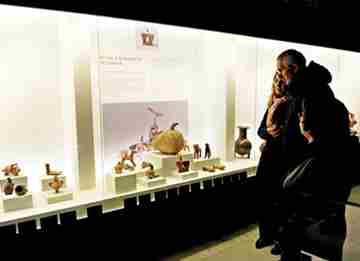Rare examples of 4,000-year-old artifacts from the ancient Assyrian kingdom are on display in Istanbul's Hagia Irene Museum, which is hosting a long-term exhibition for the first time since 1983. The exhibition features pieces unearthed during excavations in the village of Kültepe, the oldest known international trade center in Anatolia.
 Fruit boxes, pots and holy drinking glasses are among the artifacts of an ancient culture that have been unearthed in Anatolia’s oldest international trade center and are now on display at Istanbul’s Hagia Irene Museum.
Fruit boxes, pots and holy drinking glasses are among the artifacts of an ancient culture that have been unearthed in Anatolia’s oldest international trade center and are now on display at Istanbul’s Hagia Irene Museum.
It is the first time since 1983 the former Eastern Orthodox church located near Topkapı Palace has hosted a long-term exhibition, the Anatolia news agency reported Tuesday. The show of 4,000-year-old artifacts, “Foreword to Anatolia Kültepe-Kanesh Karum: Assyrians in Istanbul,” runs through March 29.
“While visiting the exhibition, I remembered a verse by the famous Turkish poet Orhan Veli: ‘Tweezers in one hand, mirror in the other. Not a care in the world!’ Because I saw that women used tweezers 4,000 years ago,” Şekib Avdagiç, the executive board chairman of the Istanbul 2010 European Capital of Culture agency, said at the exhibit’s opening. “Not too many things have changed in 4,000 years.”
Adding that the show was a fitting close to the year’s cultural activities, Avdagiç said it was a concrete example of what the agency had tried to achieve in 2010.
The artifacts in the exhibit were unearthed during excavations in the village of Kültepe, part of the Central Anatolian province of Kayseri, and are relics from Assyria, a Semitic kingdom that emerged around 2000 B.C. in northern Mesopotamia. From approximately the 20th to 16th century B.C., Kültepe was home to a large Assyrian merchant quarter. Over the summer, archaeologists working in the area discovered four-millennia-old evidence of both successful brain surgery and one of the first written trade agreements in Anatolia, the latter on cuneiform-script tablets.
The excavations that have been ongoing in the area since 1948 have highlighted Anatolian history in world archaeology, said Professor Fikri Kulakoğlu, leader of the Kültepe-Kanesh excavation. “But in spite of that we have not been very successful in introducing Kültepe to the people of Anatolia,” he said, adding that Kültepe was better known by foreigners than Turks and that they organized the exhibition within the scope of the Istanbul 2010 European Capital of Culture events in order to remedy that.
“Our goal with this exhibition is to introduce Kültepe to these people. Another goal is to bring together the rarest examples of artifacts that are displayed in two different museums,” Kulakoğlu said. “There are some 50,000 archaeological and language-related artifacts at the Anatolian Civilizations Museum in Kayseri and Ankara. Only 500 of them are being displayed; the other are kept in museum storage depots. We came up with the exhibition idea in order to show these pieces that have been in storage rather than the ones already on display.”
Noting that the exhibition’s debut came the same week as the anniversary of the opening of the Hagia Sophia Museum, with which Hagia Irene is affiliated, Associate Professor Haluk Dursun, the museums’ director, said the show of Assyrian artifacts represented a historical moment for Hagia Irene.
Dursun said valuable artworks belonging to the Assyrians had been brought from Kayseri to Istanbul and that great effort was expended to organize the exhibition.
Source: Hurriyet [December 29, 2010]